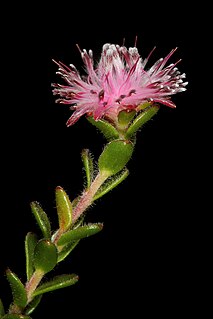
The Lamiales are an order in the asterid group of dicotyledonous flowering plants. It includes about 23,810 species, 1,059 genera, and is divided into about 24 families. Being one of the largest orders of flowering plants, Lamiales have representatives found all over the world. Well-known or economically important members of this order include lavender, lilac, olive, jasmine, the ash tree, teak, snapdragon, sesame, psyllium, garden sage, and a number of table herbs such as mint, basil, and rosemary.

Royal Botanic Gardens, Kew is a non-departmental public body in the United Kingdom sponsored by the Department for Environment, Food and Rural Affairs. An internationally important botanical research and education institution, it employs 1,100 staff. Its board of trustees is chaired by Dame Amelia Fawcett.

Loranthaceae, commonly known as the showy mistletoes, is a family of flowering plants. It consists of about 75 genera and 1,000 species of woody plants, many of them hemiparasites. The three terrestrial species are Nuytsia floribunda, Atkinsonia ligustrina, and Gaiadendron punctatum Loranthaceae are primarily xylem parasites, but their haustoria may sometimes tap the phloem, while Tristerix aphyllus is almost holoparasitic. For a more complete description of the Australian Loranthaceae, see Flora of Australia online., for the Malesian Loranthaceae see Flora of Malesia.

The Piperaceae, also known as the pepper family, are a large family of flowering plants. The group contains roughly 3,600 currently accepted species in 5 genera. The vast majority of species can be found within the two main genera: Piper and Peperomia.

The Passifloraceae are a family of flowering plants, containing about 750 species classified in around 27 genera.

The Combretaceae, often called the white mangrove family, are a family of flowering plants in the order Myrtales. The family includes about 530 species of trees, shrubs, and lianas in ca 10 genera. The family includes the leadwood tree, Combretum imberbe. Three genera, Conocarpus, Laguncularia, and Lumnitzera, grow in mangrove habitats (mangals). The Combretaceae are widespread in the subtropics and tropics. Some members of this family produce useful construction timber, such as idigbo from Terminalia ivorensis. The commonly cultivated Quisqualis indica is now placed in the genus Combretum. Many plans in the Quisqualis species contain the Non-proteinogenic amino acid excitotoxin Quisqualic acid, a potent AMPA agonist.

Linaceae is a family of flowering plants. The family is cosmopolitan, and includes about 250 species in 14 genera, classified into two subfamilies: the Linoideae and Hugonioideae. Leaves of the Linaceae are always simple; arrangement varies from alternate to opposite or whorled. The hermaphroditic, actinomorphic flowers are pentameric or, very rarely, tetrameric.

Knightia is a small genus of the family Proteaceae endemic to New Zealand, named in honor of Thomas Andrew Knight. One extant species, K. excelsa (rewarewa) is found in New Zealand. Two further Knightia species are found in New Caledonia, although they were placed in the genus Eucarpha by Lawrie Johnson and Barbara Briggs in their influential 1975 monograph "On the Proteaceae: the evolution and classification of a southern family", a placement supported in a 2006 classification of the Proteaceae. A fossil species from upper Miocene deposits in Kaikorai has been described as Knightia oblonga. Knightia has been placed in the tribe Roupaleae of the subfamily Grevilleoideae.

Myrrhis odorata, with common names cicely, sweet cicely, myrrh, garden myrrh, and sweet chervil, is a herbaceous perennial plant belonging to the celery family Apiaceae. It is the only species in the genus Myrrhis.

Heinrich Gustav Adolf Engler was a German botanist. He is notable for his work on plant taxonomy and phytogeography, such as Die natürlichen Pflanzenfamilien, edited with Karl A. E. von Prantl.

The Balanophoraceae are a subtropical to tropical family of obligate parasitic flowering plants, notable for their unusual development and formerly obscure affinities. In the broadest circumscription, the family consists of 16 genera. Alternatively, three genera may be split off into the segregate family Mystropetalaceae.

Linnaea is a plant genus in the honeysuckle family Caprifoliaceae. Until 2013, the genus included a single species, Linnaea borealis. In 2013, on the basis of molecular phylogenetic evidence, the genus was expanded to include species formerly placed in Abelia, Diabelia, Dipelta, Kolkwitzia and Vesalea. However, this is rejected by the majority of subsequent scientific literature and flora.
The Plant List was a list of botanical names of species of plants created by the Royal Botanic Gardens, Kew and the Missouri Botanical Garden and launched in 2010. It was intended to be a comprehensive record of all known names of plant species over time, and was produced in response to Target 1 of the 2002-2010 Global Strategy for Plant Conservation, to produce "An online flora of all known plants.” It has not been updated since 2013, and has been superseded by World Flora Online.

World Flora Online is an Internet-based compendium of the world's plant species.

Serruria glomerata, the cluster spiderhead, is a flower-bearing shrub that belongs to the genus Serruria and forms part of the fynbos. The plant is native to the Western Cape, it occurs on the Cape Flats and Cape Peninsula. The shrub is erect and grows only 40 cm tall and bears flowers from August to October.

Paranomus longicaulis, commonly known as exploding baked apple and woolly sceptre, is a flower-bearing shrub that belongs to the genus Paranomus and forms part of the fynbos. The plant is native to the Western Cape where it occurs on the eastern Langeberg from Garcia Pass to the Attakwaskloof.

Paranomus roodebergensis, also known as the honey-scented sceptre, is a flower-bearing shrub that belongs to the genus Paranomus and forms part of the fynbos. The plant is native to the Western Cape, South Africa.

Paranomus bolusii, the Overberg sceptre or viking sceptre, is a flower-bearing shrub that belongs to the genus Paranomus and forms part of the fynbos. The plant is native to the Western Cape, South Africa.

Diastella divaricata is a flower-bearing shrub that belongs to the genus Diastella and forms part of the fynbos. The plant is native to the Western Cape and is found on the Cape Peninsula south of the Silvermine Nature Reserve. The shrub is flat and grows only 50 cm high but 3 m in diameter and flowers throughout the year without an obvious peak.

Diastella proteoides, the Flats silkypuff, is a flower-bearing shrub that belongs to the genus Diastella and forms part of the fynbos. The plant is native to the Western Cape and occurs on the Cape Flats from Tokai to Malmesbury and Eerste River. The shrub is flat and grows only 50 cm high but 3 m in diameter and flowers throughout the year with the peak from July to February.



















